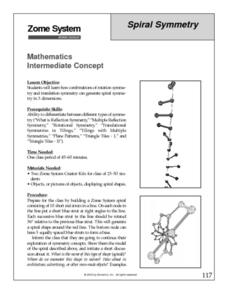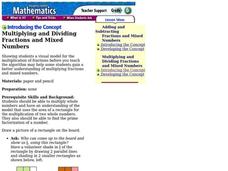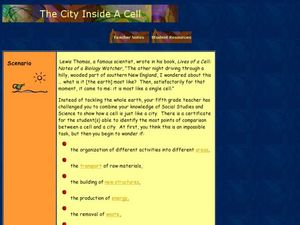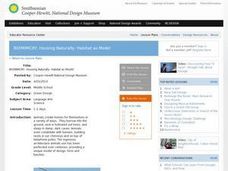Curated OER
Equivalence and Comparing Fractions
Each of these five models represents one of the fractions listed; challenge your scholars to match them up. The models consist of shapes divided into squares with the total number of squares as the denominator and a colored portion as...
Curated OER
Megabeasts
Create larger-than-life insects for the classroom. Bugs are usually pretty small, but during the Jurassic period they were huge. Kids use diagramming and scale conversion to enlarge a modern day insect so that it is as big as its ancient...
Curated OER
Spiral Symmetry
Taking the notion of symmetry to the next level, this looks at combining rotation and translation symmetry to build spiral symmetry in three dimensions. Using the Zome modeling system and an instructor’s guidance, geometers try to build...
Curated OER
Multiplying and Dividing Fractions and Mixed Numbers
Help math learners discover how to multiply fractions and mixed numbers. They will explore visual examples of the operations. They also practice solving problems that their instructor models.
Curated OER
The Brief American Pageant: American Life in the Roaring Twenties
Your lecture on the Roaring Twenties in the United States could use these two graphs. The first graph details the annual immigration and Quota Laws from 1907-29, and compares them to the McCarran-Walter Act of 1952. The second graph...
Curated OER
Model Subtraction
In this subtraction practice worksheet, learners sharpen their problem solving skills as they solve 6 story problems using the provided table.
Curated OER
Model Addition to 50
In this adding to 50 worksheet, learners use math models to help them add the numbers in the word problems. Students practice adding to 50.
Scholastic
Study Jams! Multiplication
What does baking cupcakes have to do with multiplication? Watch this video and find out as your class learns that multiplication is the repeated addition of equal groups. Properties of multiplication are also introduced with...
Curated OER
Using the Interactive Model to Explore an Authentic Written Text
Bring literature to your Spanish classroom! Small groups will read one of the selected texts from Cuentos De Eva Luna. After analyzing the text, learners will create mini-quizzes for their classmates and create a presentation discussing...
Curated OER
AP: Chapter 18: Microbial Models
AP biology and college microbiology classes benefit by completing this seven-page instructional activity on microbes. An exhaustive set of questions addresses the characteristics and reproduction of viruses, classification and uses of...
Curated OER
Subtraction with Base 10 Models
Learning how to regroup can be a difficult concept to learn, as well as teach. This PowerPoint does an excellent job at visualizing the process with step-by-step guidelines and base ten animations. There are multiple examples for...
Curated OER
Modeling Conditional Probabilities 1: Lucky Dip
Check out this detailed lesson plan on conditional probability! Learners work individually and also collaboratively to analyze the fairness of a game and justify their reasoning. it includes detailed notes and many helpful...
Curated OER
The City Inside a Cell
Middle schoolers compare cell structure to the structure of a city. In this cell structure lesson, students investigate differences and similarities between cell structure and city structure. Middle schoolers create a 3-dimensional,...
Curated OER
Creating an Enzyme-Substrate Model
Students explore the reaction rates of an enzyme-mediated reaction through experimentation. In small groups, they use everyday objects to demonstrate the effects of environmental variables on enzyme function.
Students graph and...
Curated OER
Insect Models
Students explore insects and have many opportunities to discuss, reflect, and record their explorations individually and in groups. They then make models of the insects as outlined in the activity.
Curated OER
Model Volcanoes
Students discover what causes earthquakes, volcanoes and floods. Using this information, they discuss how these natural disasters change the surface of the Earth. In groups, they make models, draw pictures and make them erupt.
Curated OER
Bottled Model Lungs
Young scholars will learn about the respiratory system by comparing and contrasting models, building their own models, and giving one another feedback. Questions about familiar body systems can be useful in getting students to start...
Curated OER
The Demographic Transition-A Contemporary Look at a Classic Model
Students evaluate and apply models to explain changes in global demographic patterns, and use their assessments to predict future needs.
Curated OER
Biology: Make a Model Cell
Young scholars compare and contrast plant and animal cells and then create a model of the latter. They visit Websites to view the cells and answer questions about them. In pairs, students create cell models using plastic baggies,...
Curated OER
Models of the Water Cycle
Students describe and review the stages in the water cycle. In groups, they build their own models of the water cycle and demonstrate where the water goes in a closed system. They answer discussion questions after the experiment to end...
Curated OER
Using Effective, Amusing Writing As a Model
Learners use the author's writing as a model to achieve vivid description and engaging humor in compositions of their own. They examine the ways a writer can capture and hold a reader's attention and write a short personal narrative...
Curated OER
BIOMIMICRY, Housing Naturally: Habitat as Model
Students explore natural animal habitats. In this lesson on biomimicry and habitation design, students will use classroom and field examples to examine animal habitats. Students will construct a model of a natural animal habitat. This...
Curated OER
Lobster Models
Pupils create and label a model of a lobster. In this lobster lesson, students become familiar with the parts of a lobster and their functions. Pupils display their lobsters in the classroom.
Curated OER
Modeling Integer Multiplication
Pupils multiply positive and negative integers. They represent word expressions with both positive and negative integers and then multiply them. They also create multiplication problems to solve as a class. They create a rhyme, a story,...
Other popular searches
- Clay Modeling
- Modeling Plate Tectonics
- Visual Math Vocabulary
- Computer Modeling
- Modeling Division
- Modeling Quadratic Functions
- Linear Modeling
- Modeling Dna Structure
- Modeling Group Work
- Modeling Day and Night
- Modeling Cell Structures
- Modeling Addition Equations























